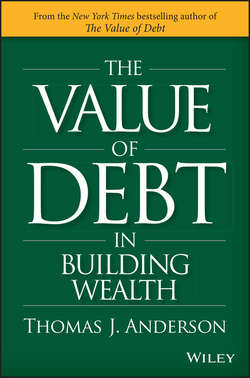Читать книгу The Value of Debt in Building Wealth - Thomas J. Anderson - Страница 9
На сайте Литреса книга снята с продажи.
Chapter 1
The Traditional Glide Path
In a Perfect World, No Debt! But Our World Isn't Perfect
ОглавлениеDebt is risky, and, in a perfect world, we would all rather avoid risk. The problem is that we do not live in a perfect world.
In their Nobel Prize–winning economic theorem, Franco Modigliani and Merton Miller hypothesize that capital structure (how much debt a company has) doesn't matter in a perfect world, but we don't live in one.2 In our imperfect world, how much debt companies carry matters quite a bit. Companies carry debt because it works for their bottom line even though they likely have the resources or could raise money to pay for things in cash.
People, on the other hand, do not have this luxury. Our ability to buy things is limited to our income, assets, and use of debt. No one would need debt if we could rent everything we want and need, under terms and conditions we find desirable, and at a cost equal to what it would cost to borrow money to buy. In this perfect world, most people would be neutral to renting versus buying – and renting would often make more sense.3 You don't buy a car and house for a one-week vacation in Hawaii. You rent because the terms and conditions are much better than buying. This same concept could apply to everything in your life, but it doesn't for a combination of financial and emotional reasons.
In our imperfect world, many people use debt to buy things they could not otherwise afford with cash they have on hand, including houses, cars, education, or investing in their small business.4 As a result, many – if not most – people choose to take on debt early in life and spend their lives trying to pay it down. Is this a good strategy? Should people borrow money? If so, how much should they borrow? How fast should it be paid down? How does buying compare to the alternatives?
HOUSTON – WE HAVE A PROBLEM!
The vast majority of us use debt as a tool at some point in our lives and race to pay it off because we perceive it adds little to no value and adds stress to our lives. At the same time, most people desire to ultimately retire, yet are not on track for retirement. Is it possible that we can find balance in this tug of war between paying off debt and being on track for retirement?
A survey of college graduates who make more than $50,000 per year indicates:5
● 93 percent plan to retire by age 75 (and 86 percent before age 70).
● 85 percent of those surveyed either have debt or plan to use debt at some point in their life.
● 93 percent want to retire debt free.
● Only 27 percent think it is even possible that having debt in retirement is a good idea.
● 73 percent say that debt increases stress.
● 96 percent would choose to not have debt if they had the choice.
● 50 percent do not feel on track for retirement, and studies indicate that as many as 90 percent of Americans fail tests for meeting future retirement needs.6
2
See the concepts of weighted average cost of capital and the Modigliani-Miller Theorem: F. Modigliani and M. Miller, “The Cost of Capital, Corporation Finance, and the Theory of Investment,” American Economic Review 48, no. 3 (1958); F. Modigliani and M. Miller, “Corporate Income Taxes and the Cost of Capital: A Correction,” American Economic Review 53, no. 3 (1963).
3
This is not an impossibility. For example, if housing is a great investment that maintains its value after depreciation, then investors should be willing to buy houses and rent them at a low rate to consumers, capturing not only the rental income, but also the appreciation of the asset as their total return. Rental rates could in fact be lower than purchasing rates. This in fact happens in many markets today, within and outside of housing.
4
Note that many consumers' desire to own is not limited to assets that we perceive to be likely to go up in value over time. Consumers also want to own items that are more likely to go down in value such as cars, boats, clothing, and intangible assets such as education (which theoretically leads to higher productivity and wages, a positive trade-off, or better future opportunity).
5
Results based on survey conducted by Supernova Companies in December 2015. The survey featured 394 respondents who met the following criteria: age 21–60, minimum of college degree, and annual income of at least $50,000. Full results are available here: https://www.surveymonkey.com/results/SM-KCDY3XGJ/.
6
Nari Rhee, “The Retirement Crisis: Is it Worse than We Think?” National Institute on Retirement Security (June 2013). http://www.nirsonline.org/storage/nirs/documents/Retirement%20Savings%2 °Crisis/retirementsavingscrisis_final.pdf.
